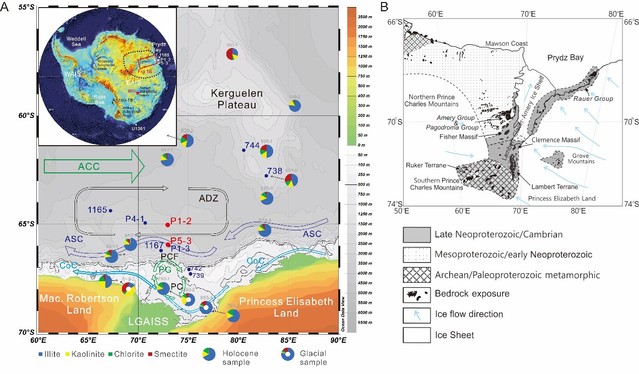Li Wu1, David J. Wilson2, Rujian Wang1*, Sandra Passchier3, Wout Krijgsman4, Xun Yu1, Tingyu Wen1, Wenshen Xiao1, Zhifei Liu1
1. State Key Laboratory of Marine Geology, TongjiUniversity, Shanghai, China
2. Institute of Earth and Planetary Sciences, UniversityCollegeLondon and Birkbeck, University of London, London, UK
3. Department of Earth and Environmental Studies, MontclairStateUniversity, Upper Montclair, New Jersey, USA
4. Department of Earth Sciences, UtrechtUniversity, Utrecht, The Netherlands
Abstract
The Lambert Glacier-Amery Ice Shelf system (LGAISS) is the largest outlet glacier system in East Antarctica but its response to past climate variability is poorly constrained. In this study, we explore its dynamics over the last ~520 thousand years using new high-resolution sedimentary records retrieved off PrydzBay. Episodic occurrences of iceberg rafted debris indicate a dynamic ice sheet throughout this interval, while changes in clay mineral compositions provide detailed evidence on the waxing and waning of the LGAISS. Our data indicate that advance and retreat of the LGAISS was sensitive to oceanic forcing, but also responded to local summer insolation when insolation peaks combined with interglacial sea level high stands. Subglacial bed topography may have played an additional role in modulating the LGAISS behaviour, which could explain sectoral differences in the response of the East Antarctic Ice Sheet to climate change. Overall, our records indicate that the LGAISS advanced more extensively during previous late Quaternary glacial periods than during Marine Isotope Stages 2 and 4. Furthermore, the LGAISS retreated more significantly than present during Marine Isotope Stage 13, and only moderately during Marine Isotope Stage 7, which suggests that the duration of warm climatic states could be a key factor affecting the dynamics of the East Antarctic Ice Sheet.
Full Article: https://www.sciencedirect.com/science/article/pii/S0277379120307009?via%3Dihub




